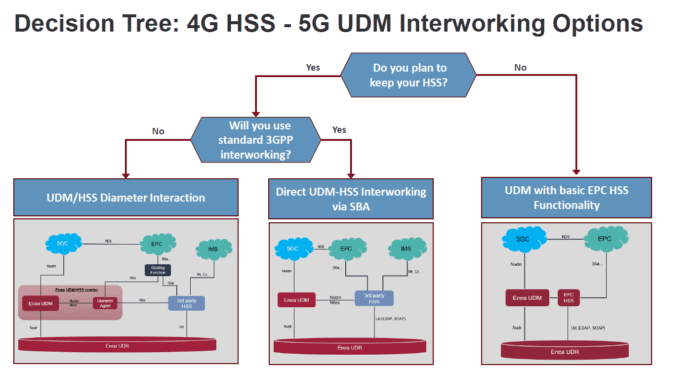You can’t keep a good technology down! According to recent industry data, 5G is the fastest growing mobile technology in history – despite a pandemic and widespread lockdowns. Between Q3 2019 and Q3 2020, there were 225 million 5G subscribers. This remarkable feat took 4G LTE four years to attain. And while 5G will come to dominate the mobile landscape in the future, 4G is not going away anytime soon. The GSMA estimates that 4G will in fact grow and still account for 56 per cent of connections in 2025. The time is now for operators to have a robust strategy to achieve seamless 4G to 5G interconnectivity.
The strategy for subscriber data management needs to reconcile different systems and standards that have been applied to achieve successful – and seamless – network transformation. As legacy 4G networks will run alongside 5G for the foreseeable future, interworking is essential for reliable access to subscriber data for user registration, network profiles, and service monetization.
According to 3GPP Release 16 standardization, the 5G core subscriber data management system replacing Home Subscriber Server (HSS) systems is Unified Data Management (UDM). Cloud-native UDM technology provides a centralized way to control network user data designed specifically for 5G. Yet there are several different options available for interworking between 4G HSS and a 5G UDM system. So, how can operators choose the best data management strategy to ensure seamless interworking with 4G while introducing lucrative new 5G services?
Data management interworking
When evaluating options for interworking between 4G and 5G subscriber data management, it’s important to consider a few key points: the type of interface preferred; the process for handling of legacy subscribers in old and new security elements; and a centralized versus separated subscriber database. Data management interworking can be based either on the 4G diameter interfaces or on the new service-based architecture (SBA).
The 3GPP standard outlines a number of options for subscriber data management integration in TR 23.732 and TR 23.973 – an extension of this decision tree can be found belo. Essentially, there are three main approaches that can be taken for efficient interworking to ensure that a 5G standalone (5G SA) core network can coexist with legacy subscriber data management systems.

- UDM-HSS Interworking via SBA
This option, standardized in 3GPP’s proposed interworking approach, leverages SBA technology to achieve interworking. This approach requires changes to the legacy HSS to add SBA support, but it enables seamless interworking between 3G, 4G and 5G environments. By specifying a new service based interface (SBI) between UDM and HSS — referred to as User Data Interworking, Coexistence and Migration (UDICOM) in the 3GPP standards — this first option allows a smooth evolution to 5G Core SA and allows operators to leverage the full potential of agile 5G architecture. As a result, operators can evolve at their own pace while introducing disruptive edge services with shorter deployment time.
- UDM-HSS Diameter Interaction
Alternatively, the second option uses diameter interfaces already available in legacy HSS systems. In this approach, also proposed in the 3GPP standard, the UDM acts as a gateway and sole access point, offering a smooth evolution towards shutting down the HSS. Specifically, the UDM in its gateway role reproduces 4G Evolved Packet Core (EPC) elements, such as the Mobility Management Entity (MME), to support essential 4G diameter interfaces and procedures to serve 5G subscribers roaming in 4G, as well as 4G subscribers in 5G SA. This approach enables a smooth integration without requiring any changes to the existing HSS.
- UDM with HSS Features
With this third option, the UDM supports Nudm interfaces for 5G Core procedures, but also introduces mini-HSS support with S6a interface for Evolved Packet System (EPS) procedures. The S6a interface is introduced to support 4G EPS procedures between the MME and HSS. The UDM network function provides authentication and subscription information to the 5G Core network functions that are generally concerned with controlling network access and establishing a subscriber’s session. This approach offers the opportunity to introduce 5G subscription data without impacting or migrating legacy subscription data that is already provisioned.
The road ahead
The transition from 4G to 5G is a substantial shift, offering considerable flexibility with independence between the network data layer and the network functions in the control plane. Consideration should be given to potential use cases and the manner in which subscriber data is managed in the control plane; both new 5G users on 4G radio, as well as legacy 4G users on 5G radio. Mission critical 5G use cases from telehealth and robotics to connected cars all require seamless, reliable data transmission.
4G networks will continue to operate alongside 5G architecture for the foreseeable future, requiring interworking between the systems to provide service for all types of subscribers. Fortunately, several flexible interworking options have been specified in the 3GPP standards to support the transition to UDM systems. Whichever strategy each operator chooses, the key to a smooth journey will be taking an important first step with deployment of a data management system capable of effective operation in a mixed 4G/5G environment. With 5G on the ascendancy, that need has never been more pressing.

